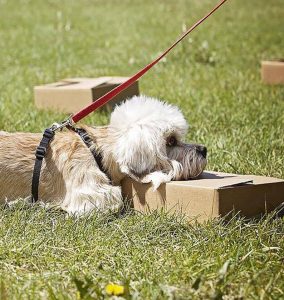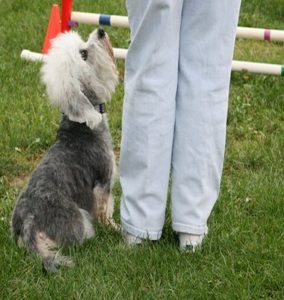Obedience
Taking your Dandie to an obedience class is the first step to train you dog. Just like most breeds, it is easier to train your Dandie Dinmont when it is a puppy. However, Dandies love the attention and want to please you, so take the time to train your dog whether it is a puppy or an adult.
The benefits of obedience besides safety for you and your Dandie as well as a well-adjusted dog for your lifestyle, can be additional options for your companion. If you eventually want to acquire certifications for Canine Good Citizen or Therapy Dogs, this is where you will start.
You can often take an obedience class through your local club or with local trainers. Options are typically a puppy class: 3-5 months, a basic class: older than 5 months, and the companion classes.
Companion classes help you prepare your Dandie Dinmont for competition in many other AKC events such rally or agility.
Obedience Eligibility
Obedience trials are open to all dogs. There are different types of trials offered by clubs, specifically:
- All-Breed Obedience Trials – the most common types of trials
- Specialty Trials are open to specific breeds or varieties within one breed.
To compete, your dog must be:
- At least 6 months of age.
- Physically sound.
- Have an AKC registration number.
In addition:
- Spayed females and neutered males are eligible to participate, but females in season are not.
- A dog that is blind is not eligible to participate.
- No dog may compete if it is taped or bandaged or has anything attached to it in any way for medical purposes.
- It is important that before competing, you have trained your dog for the required skills and you have familiarized yourself with the AKC Obedience Regulations and ring procedures.
Rally
 You and your Dandie navigate a course, side-by-side, as you steer him through a course of 10-20 different signs. Each of these signs provides instructions regarding the next skill that is to be performed. The dog and handler move continuously throughout the course with the dog under control at the handler’s left side. There is a clear sense of teamwork with your Dandie during and between the numbered signs. Although each performance is timed, having a good race time is not the goal; it’s all about working as a team while performing the skills, with your Dandie under your control.
You and your Dandie navigate a course, side-by-side, as you steer him through a course of 10-20 different signs. Each of these signs provides instructions regarding the next skill that is to be performed. The dog and handler move continuously throughout the course with the dog under control at the handler’s left side. There is a clear sense of teamwork with your Dandie during and between the numbered signs. Although each performance is timed, having a good race time is not the goal; it’s all about working as a team while performing the skills, with your Dandie under your control.
Start by taking a Rally Class. Enter a Rally trial.
Rally Eligibility:
To be eligible to compete, your Dandie must be:
- 6 months of age or older
- Have an AKC registration number
- Spayed females and neutered males are eligible to participate but females in season are not.
- Dogs that are deaf are allowed to participate, but dogs that are blind are not eligible.
- No dog can compete if it is taped or bandaged or in any way has anything attached to it for medical purposes.
There are six levels of Classes in AKC Rally:
- Novice is for those just getting started:
- All exercises are performed with your dog on leash.
- There are 10-15 signs.
- Exercises vary from turning 360 degrees to changing paces during the course.
- You may talk, clap your hands and/or pat your legs to encourage your dog.
- To earn a title, it takes three qualifying scores.
- Intermediate/Advanced Classes:
- After Novice, handlers may choose which class they are ready to participate in, either the Intermediate or Advanced level.
- All exercises are performed on-leash in the Intermediate level and there is no jump required.
- All exercises are performed off-leash in the Advanced level and there is one jump required.
- There are 12-17 signs.
- To earn a title, it takes three qualifying scores.
- Excellent is the next level of competition. The course is like the Advanced level (above), but with some more challenging exercises.
- All exercises are performed off-leash.
- Handlers are not allowed to pat their legs or clap their hands to encourage the dog.
- Dogs must jump twice.
- There are 15-20 signs.
- To earn a title, it takes three qualifying scores.
- Master/Choice: These classes are the highest level of competition.
- All exercises are performed off-leash.
- Handlers are not allowed to pat their legs or clap their hands to encourage the dog.
- Dogs must jump once in Master, no jumps in Choice
- There are 15-20 signs
- To earn a title, it takes ten qualifying scores.

